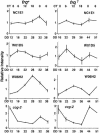Multiple oscillators regulate circadian gene expression in Neurospora
- PMID: 14597725
- PMCID: PMC263859
- DOI: 10.1073/pnas.2233734100
Multiple oscillators regulate circadian gene expression in Neurospora
Abstract
High-density microarrays were used to profile circadian gene expression in Neurospora crassa cultures grown in constant darkness. We identified 145 clock-controlled genes (ccgs). The ccgs peaked in mRNA accumulation at all phases of the day, with the majority peaking in the late night to early morning. The predicted or known functions of the ccgs demonstrate that the clock contributes to a wide range of cellular processes, including cell signaling, development, metabolism, and stress responses. Although the period of rhythm of most of the ccgs was found to depend on the well characterized frequency (FRQ)-based oscillator, three ccgs appeared to have a rhythm that was significantly short in the long period (29-h) frq7 mutant strain. These ccgs accumulate mRNA rhythmically with a circadian period in a frq-null strain, confirming the existence of a second oscillator in N. crassa.
Figures



References
-
- Edmunds, L. N. (1988) Cellular and Molecular Bases of Biological Clocks (Springer, New York).
-
- Young, M. W. & Kay, S. A. (2001) Nat. Rev. Genet. 2, 702-715. - PubMed
-
- Loros, J. J. & Dunlap, J. C. (2001) Annu. Rev. Physiol. 63, 757-794. - PubMed
-
- He, Q., Cheng, P., Yang, Y., Wang, L., Gardner, K. H. & Liu, Y. (2002) Science 297, 840-843. - PubMed
-
- Froehlich, A. C., Liu, Y., Loros, J. J. & Dunlap, J. C. (2002) Science 297, 815-819. - PubMed
Publication types
MeSH terms
Substances
Grants and funding
LinkOut - more resources
Full Text Sources
Other Literature Sources

